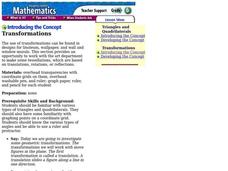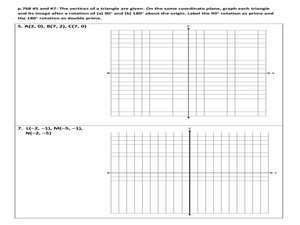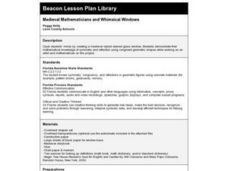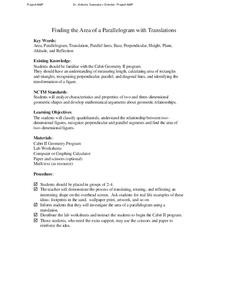EngageNY
Directed Line Segments and Vectors
Investigate the components of vectors and vector addition through geometric representations. Pupils learn the parallelogram rule for adding vectors and demonstrate their understanding graphically. They utilize the correct notation and...
NTTI
Transform Your Geometry into a Work of Art
Mathematicians utilize artwork to help illustrate the major ideas of transformations and tessellations. They visually identify transformations including reflections, rotations, and translations. They discuss how artists have used...
Futures Channel
Algebra Magic
Abracadabra! Letters can be used in math to represent numbers with the operations of addition, subtraction, multiplication, and division to solve problems! Math magicians will participate in an activity that uses a calculator and a bag...
Association for Supervision and Curriculum Development (ASCD)
Interpreting Algebraic Expressions
The title of this lesson should be "Algebraic Expressions Four Ways." Not only will your class be translating verbal descriptions of algebraic expressions to symbols, but also working with their geometric interpretation via area as well...
Curated OER
Let's Tesselate
Students investigate the geometrical concepts of translation, reflection, and rotation. They make different observations looking for the concepts that are displayed in classroom items like floor tiles, carpet designs, and visuals hung in...
Curated OER
Transformation
Third graders investigate symmetry by reflecting objects in different angles. In this geometrical transformation lesson, 3rd graders define the terms translation, rotation and reflection in order to physically turn geometric...
Curated OER
Transformations
Young scholars draw on graph paper. In this geometry lesson plan, students review types of triangles and quadrilaterals. Young scholars investigate geometric transformations, including translation, rotation and reflection. Students...
Curated OER
Lines of Symmetry
Fourth graders demonstrate lines of symmetry using polygons, pentominoes, and block letters of the alphabet. They describe, identify, and analyze characteristics and properties of geometric shapes.
Curated OER
Transformations
In this geometry worksheet students rotate, reflect, and translate geometric shapes. The four page worksheet contains seventeen problems Solutions are not provided.
Curated OER
Geometry and Spatial Reasoning 2
In this math worksheet, students use pictures of hands, bears, and cartoon characters to review geometrical terms including reflections and rotations.
Curated OER
Problem Solving Using Power Polygons
Students investigate geometric shapes by creating figures on a plane. In this polygon lesson plan, students complete a worksheet based on the angles in a power polygon. Students identify the different types of polygons and define their...
Curated OER
Figuring in Football
Students identify and visualize congruent and similar two-dimensional geometric figures. They recognize that rotations, translations, and reflections do not change geometric figures. Students participate in activites in which they...
Curated OER
Medieval Mathematicians and Whimsical Windows
Third graders demonstrate their mathematical knowledge of symmetry and reflection using congruent geometric shapes while working as an artist and mathematician looking at a medieval-styled stained glass window.
Curated OER
Effect of Transformations on Coordinates
In this effect of transformations on coordinates worksheet, learners determine the coordinates of 4 geometric shapes on a grid after a given transformation.
Shodor Education Foundation
Visual Patterns in Tessellations
Geometers explore the concept of tessellations. They use a tessellation applet to manipulate shapes and design their own tessellation using the applet.
Curated OER
Twists and Turns
Students reflect, rotate, translate, and dilate figures in the Cartesian coordinate plane using grid paper and dot paper. They use transformations (i.e., reflections, translations, rotations, and dilations) to describe geometric patterns...
Curated OER
Transformations on the Coordinate Plane
Here is a study guide on transformations that includes reflections, translations, dilations, and rotations. It also has definitions, helpful diagrams, and several examples involving transformations on the coordinate plane. The lesson...
Curated OER
Crayon Resist
Kids usually love crayon resist projects. It is so fascinating for them to see how the dark paint accentuates and resists the waxy crayon. Here are instructions for executing a crayon resist project of your own. Tip: Make the project fit...
Illustrative Mathematics
Complex number patterns
Start off with the definition of the imaginary number i, then have your class practice simplifying expressions involving powers of i and look for patterns. See how the cyclic nature of powers of i translate to sums of powers of i.
Curated OER
Transformations-Shapes on the Move
Learners examine transformations. For this math lesson, students view and describe flips, slides, and turns. Learners practice making transformations with shapes.
Curated OER
Finding the Area of a Parallelogram with Translations
Students calculate the area of parallelograms. In this geometry instructional activity, students identify properties of parallelograms and use to to solve problems. They create polygons using Cabri software.
Mathematics Vision Project
Module 6: Congruence, Construction, and Proof
Trace the links between a variety of math concepts in this far-reaching unit. Ideas that seem very different on the outset (like the distance formula and rigid transformations) come together in very natural and logical ways. This unit...
EngageNY
Definition of Congruence and Some Basic Properties
Build a definition of congruence from an understanding of rigid transformations. The lesson plan asks pupils to explain congruence through a series of transformations. Properties of congruence emerge as they make comparisons to these...
West Contra Costa Unified School District
Congruence Through Transformations
Transform your lesson on transformations. Learners use given congruent triangles and tracing paper to determine the single transformation that carries one to the other. The concept is extended to combinations of transformations to...

























